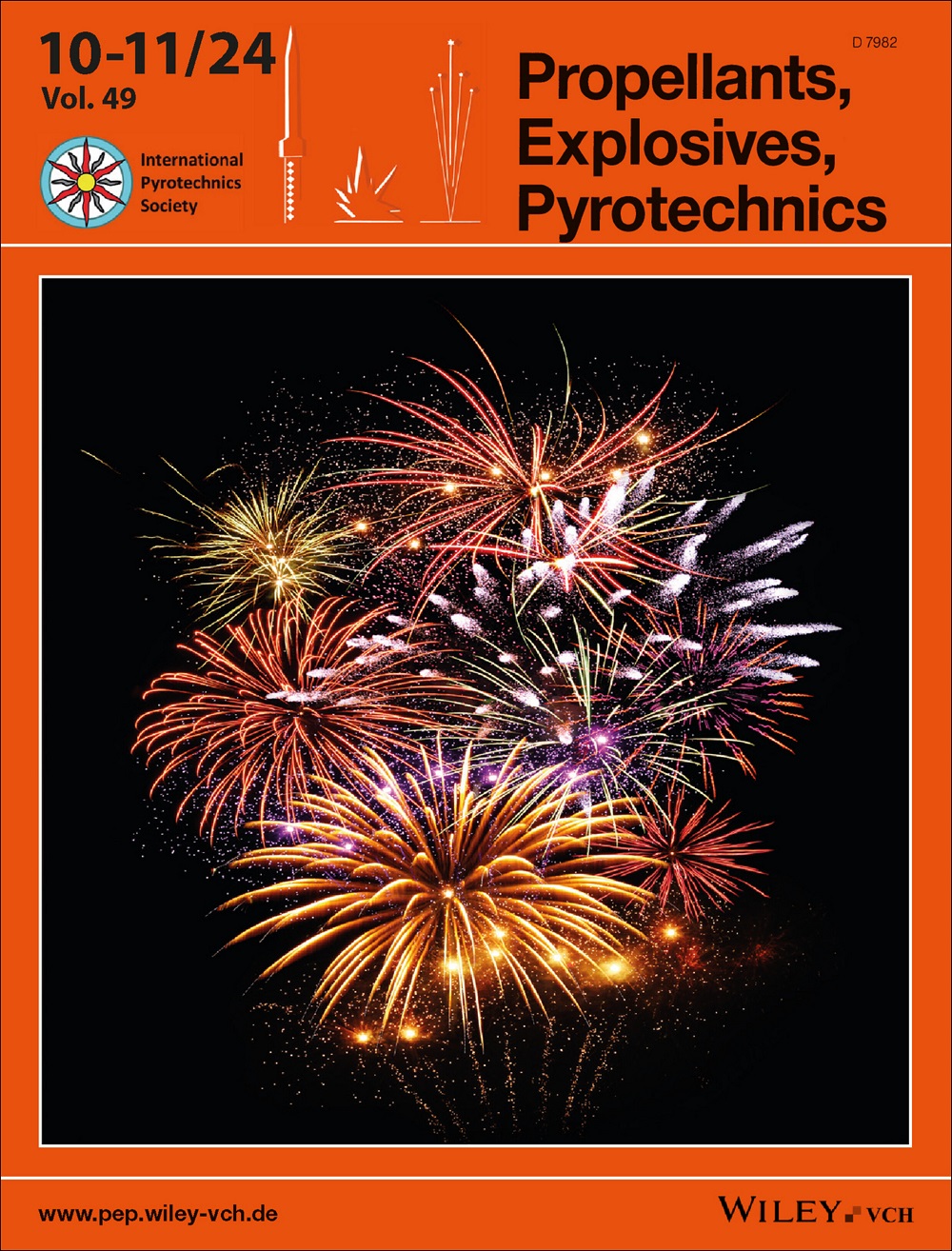On‐demand microwave growth of porosity within a granular composite energetic material: Void formation via a dielectric loss phase change binder additive for propellant burning rate control
IF 2
4区 工程技术
Q3 CHEMISTRY, APPLIED
引用次数: 0
Abstract
This study demonstrates, for the first time ever, the ability to grow, in an on‐command fashion, porosity within a granular composite energetic material to effect a change in energy output rate. Specifically, the study investigates the change in burning rates of ammonium perchlorate composite propellants as a result of porosity created in situ via microwave field‐driven volatilization of the low boiling point binder additive, ethylene glycol. Theoretical mass densities were measured before and after microwave irradiation finding that the maximum observed %TMD change for tested propellants is 6 %. Propellants were burned at 1.72 MPa to 6.89 MPa pressures, finding that for all propellants, microwave irradiation produced a change in ballistic characteristics. Most propellant formulations demonstrate acceptable burning rate parameters for use within rocket motors; some exhibited a large change in their pressure exponent as well as slope breaks attributed to the onset of convective burning, while microwave irradiation produced no change in burning rate or density in reference propellants without the additive. Microwave heating simulation results are presented to gain insight into the thermal environment of the propellant during microwave irradiation. These results provide valuable insight into propellant formulations that can have their burning rates (and thus the thrust profile for motor grains) altered after casting via microwave irradiation.在颗粒状复合高能材料中按需用微波制造孔隙:通过介电损耗相变粘合剂添加剂形成空隙,控制推进剂燃烧速率
这项研究首次展示了在颗粒状复合高能材料中按指令增加孔隙率以改变能量输出率的能力。具体来说,该研究调查了通过微波场驱动低沸点粘合剂添加剂乙二醇的挥发而在原位产生的多孔性所导致的高氯酸铵复合推进剂燃烧速率的变化。对微波辐照前后的理论质量密度进行测量后发现,测试推进剂的最大理论质量密度变化率为 6%。在 1.72 兆帕至 6.89 兆帕的压力下燃烧推进剂,发现对所有推进剂来说,微波辐照都会导致弹道特性发生变化。大多数推进剂配方显示了可接受的燃烧速率参数,可用于火箭发动机;一些推进剂显示了压力指数的巨大变化以及斜率断裂,这归因于对流燃烧的开始,而微波辐照对不含添加剂的参考推进剂的燃烧速率或密度没有产生任何变化。介绍微波加热模拟结果是为了深入了解微波辐照期间推进剂的热环境。这些结果为我们深入了解推进剂配方提供了宝贵的资料,这些配方在通过微波辐照进行浇注后,其燃烧速率(以及发动机晶粒的推力曲线)可能会发生变化。
本文章由计算机程序翻译,如有差异,请以英文原文为准。
求助全文
约1分钟内获得全文
求助全文
来源期刊

Propellants, Explosives, Pyrotechnics
工程技术-工程:化工
CiteScore
4.20
自引率
16.70%
发文量
235
审稿时长
2.7 months
期刊介绍:
Propellants, Explosives, Pyrotechnics (PEP) is an international, peer-reviewed journal containing Full Papers, Short Communications, critical Reviews, as well as details of forthcoming meetings and book reviews concerned with the research, development and production in relation to propellants, explosives, and pyrotechnics for all applications. Being the official journal of the International Pyrotechnics Society, PEP is a vital medium and the state-of-the-art forum for the exchange of science and technology in energetic materials. PEP is published 12 times a year.
PEP is devoted to advancing the science, technology and engineering elements in the storage and manipulation of chemical energy, specifically in propellants, explosives and pyrotechnics. Articles should provide scientific context, articulate impact, and be generally applicable to the energetic materials and wider scientific community. PEP is not a defense journal and does not feature the weaponization of materials and related systems or include information that would aid in the development or utilization of improvised explosive systems, e.g., synthesis routes to terrorist explosives.
 求助内容:
求助内容: 应助结果提醒方式:
应助结果提醒方式:


